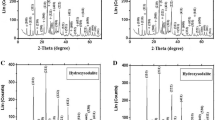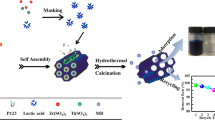Abstract
In this paper, analcime and zeolite X were fabricated using the hydrothermal method in the presence of L-alanine and glycine as organic structure-directing agents, respectively. The XRD confirmed that the average crystallite size of zeolite X and analcime products is 94.85 and 146.06 nm, respectively. Also, the FE-SEM confirmed that the zeolite X composed of an octahedron and cubic shapes with an average size of ca. 2.78 µm. Besides, the analcime composed of droxtal shapes with an average size of ca. 9.50 µm. Vibrations of adsorbed water, aluminol, silanol, Si–O–Si, and Si–O–Al groups were obtained using the FT-IR spectrophotometer. Moreover, the fabricated products were utilized for the removal of Cd(II) ions from aqueous media and wastewater which was collected from an electroplating factory in the 10th of Ramadan City, Egypt. The pseudo-second-order model and Langmuir isotherm were the best fittings for the experimental results. The removal of Cd(II) ions was exothermic because the values of ∆Ho in the case of zeolite X and analcime were − 49.859 and -61.647 kJ/mol, respectively. Also, the removal of Cd(II) ions was spontaneous because the values of ΔGo in the case of zeolite X and analcime were − 101.678 and − 119.669 kJ/mol at 298 K, respectively. Besides, the maximum adsorption capacity of analcime and zeolite X was 139.278 and 62.814 mg/g, respectively. Moreover, the fabricated samples are reusable, effective, stable, and can be utilized over and over without surrendering their efficiency towards Cd(II) ions in aqueous solutions and wastewater.












Similar content being viewed by others
References
A. Jawed, V. Saxena, L.M. Pandey, Engineered nanomaterials and their surface functionalization for the removal of heavy metals: a review. J. Water Process Eng. 33, 101009 (2020)
L. Joseph, B. Jun, J.R.V. Flora, C. Min, Y. Yoon, Removal of heavy metals from water sources in the developing world using low-cost materials : a review. Chemosphere 229, 142–159 (2019)
D. Singh, R. Kumar, R. Kumar, B. Kumar, V. Shankar, V. Krishna, Citric acid coated magnetic nanoparticles : synthesis, characterization and application in removal of Cd(II) ions from aqueous solution. J. Water Process Eng. 4, 233–241 (2014)
D. Purkayastha, U. Mishra, S. Biswas, A comprehensive review on Cd(II) removal from aqueous solution. J. Water Process Eng. 2, 105–128 (2014)
Y.Z. Cuevas, G. Martínez-nava, J. Fernández-torres, A. Olivos-meza, C. Landa-solis, M.C. Gutiérrez-ruiz, L. Guillermo, I. Ibarra, C. Mexico-xochimilco, Toxicity of cadmium in musculoskeletal diseases. Environ. Toxicol. Pharmacol. 72, 103219 (2019)
F. Fu, Q. Wang, Removal of heavy metal ions from wastewaters : a review. J. Environ. Manage. 92, 407–418 (2011)
X. Lin, R.C. Burns, G.A. Lawrance, Heavy metals in wastewater: the effect of electrolyte composition on the precipitation of cadmium(ii) using lime and magnesia. Water Air Soil Pollut. 165, 131–152 (2005)
M. Kobya, E. Demirbas, N.U. Parlak, S. Yigit, Treatment of cadmium and nickel electroplating rinse water by electrocoagulation. Environ. Technol. 31, 1471–1481 (2010)
G. Chen, Electrochemical technologies in wastewater treatment. Sep. Purif. Technol. 38, 11–41 (2004)
M.J. Polovina, S. Cupic, B.V. Kaludjerovic, B.M. Babic, Adsorption of zinc, cadmium and mercury ions from aqueous solutions on an activated carbon cloth. Carbon 40, 1109–1115 (2002)
M. Streat, Adsorption of cadmium by activated carbon cloth: influence of surface oxidation and solution pH. Water Res. 36, 1244–1252 (2002)
K. Kesenci, R. Say, A. Denizli, Removal of heavy metal ions from water by using poly (ethyleneglycol dimethacrylate-co-acrylamide) beads. Eur. Polym. J. 38, 1443–1448 (2002)
B. Salih, A. Denizli, C. Kavaklı, R. Say, E. Pis, Adsorption of heavy metal ions onto dithizone-anchored poly (EGDMA-HEMA) microbeads. Talanta 46, 1205–1213 (1998)
G.N. Manju, K.A. Krishnan, V.P. Vinod, T.S. Anirudhan, An investigation into the sorption of heavy metals from wastewaters by polyacrylamide-grafted iron (III) oxide. J. Hazard. Mater. 91, 221–238 (2002)
K.C. Justi, V.T. Fávere, M.C.M. Laranjeira, A. Neves, R.A. Peralta, Kinetics and equilibrium adsorption of Cu(II), Cd(II), and Ni(II) ions by chitosan functionalized with 2 [-bis-( pyridylmethyl ) aminomethyl]-4-methyl-6-formylphenol. J. Colloid. Interf. Sci. 291, 369–374 (2005)
A. Duran, M. Soylak, S.A. Tuncel, Poly (vinyl pyridine-poly ethylene glycol methacrylate-ethylene glycol dimethacrylate) beads for heavy metal removal. J. Hazard. Mater. 155, 114–120 (2008)
M. Kumar, B.P. Tripathi, V.K. Shahi, Crosslinked chitosan/polyvinyl alcohol blend beads for removal and recovery of Cd(II) from wastewater. J. Hazard. Mater. 172, 1041–1048 (2009)
P.A. Amoyaw, M. Williams, X.R. Bu, The fast removal of low concentration of cadmium(II) from aqueous media by chelating polymers with salicylaldehyde units. J. Hazard. Mater. 170, 22–26 (2009)
G.P. Rao, C. Lu, F. Su, Sorption of divalent metal ions from aqueous solution by carbon nanotubes: a review. Sep. Purif. Technol. 58, 224–231 (2007)
M. Hua, S. Zhang, B. Pan, W. Zhang, L. Lv, Q. Zhang, Heavy metal removal from water / wastewater by nanosized metal oxides: a review. J. Hazard. Mater. 212, 317–331 (2012)
E.A. Deliyanni, K.A. Matis, Sorption of Cd ions onto akagan ´ eite-type nanocrystals. Sep. Purif. Technol. 45, 96–102 (2005)
A.D. Marinkovi, M. Coli, M.Ð. Risti, G.D. Vukovi, A.A. Peri, Removal of cadmium from aqueous solutions by oxidized and ethylenediamine-functionalized multi-walled carbon nanotubes. Chem. Eng. J. 157, 238–248 (2010)
Q. Su, B. Pan, S. Wan, W. Zhang, L. Lv, Use of hydrous manganese dioxide as a potential sorbent for selective removal of lead, cadmium, and zinc ions from water. J. Colloid Interface Sci. 349, 607–612 (2010)
H.K. Boparai, M. Joseph, D.M.O. Carroll, Kinetics and thermodynamics of cadmium ion removal by adsorption onto nano zerovalent iron particles. J. Hazard. Mater. 186, 458–465 (2011)
T. Agustiono, G.Y.S. Chan, W. Lo, S. Babel, Comparisons of low-cost adsorbents for treating wastewaters laden with heavy metals. Sci. Total Environ. 366, 409–426 (2006)
J. Liu, Z. Huang, J. Sun, Y. Zou, B. Gong, Enhancing the removal performance of Cd(II) from aqueous solutions by NaA zeolite through doped thiourea reduced GO which is trapped within zeolite crystals. J. Alloys Compd. 815, 152514 (2020)
Y. Chen, A. Armutlulu, W. Sun, W. Jiang, X. Jiang, Ultrafast removal of Cu(II) by a novel hierarchically structured faujasite-type zeolite fabricated from lithium silica fume. Total Environ. Sci. (2020). https://doi.org/10.1016/j.scitotenv.2020.136724
E.A. Abdelrahman, R.M. Hegazey, Utilization of waste aluminum cans in the fabrication of hydroxysodalite nanoparticles and their chitosan biopolymer composites for the removal of Ni(II) and Pb(II) ions from aqueous solutions : kinetic, equilibrium, and reusability studies. Microchem. J. 145, 18–25 (2019)
E.A. Abdelrahman, Synthesis of zeolite nanostructures from waste aluminum cans for efficient removal of malachite green dye from aqueous media. J. Mol. Liq. 253, 72–82 (2018)
E.A. Abdelrahman, R.M. Hegazey, A. Alharbi, Facile Synthesis of mordenite nanoparticles for efficient removal of Pb(II) ions from aqueous media. J. Inorg. Organomet. Polym. Mater. (2019). https://doi.org/10.1007/s10904-019-01238-5
S. El-nahas, A.I. Osman, A.S. Arafat, A.H. Al-Muhtaseb, Facile and affordable synthetic route of nano powder zeolite and its application in fast softening of water hardness. J. Water Process Eng. 33, 101104 (2020)
E.A. Abdelrahman, A. Subaihi, Application of geopolymers modified with chitosan as novel composites for efficient removal of Hg(II), Cd(II), and Pb(II) ions from aqueous media. J. Inorg. Organomet. Polym. Mater. (2019). https://doi.org/10.1007/s10904-019-01380-0
M.E. Khalifa, E.A. Abdelrahman, M.M. Hassanien, W.A. Ibrahim, Application of mesoporous silica nanoparticles modified with dibenzoylmethane as a novel composite for efficient removal of Cd(II), Hg(II), and Cu(II) ions from aqueous media. J. Inorg. Organomet. Polym. Mater. (2019). https://doi.org/10.1007/s10904-019-01384-w
T. Sirinakorn, S. Bureekaew, M. Ogawa, Layered titanates (Na2Ti3O7 and Cs2Ti5O11) as very high capacity adsorbents of cadmium(II). Bull. Chem. Soc. Jpn. 92, 1–6 (2019)
M.R. Karim, M.O. Aijaz, N.H. Alharth, H.F. Alharbi, F.S. Al-Mubaddel, M.R. Awual, Composite nanofibers membranes of poly(vinyl alcohol)/chitosan for selective lead(II) and cadmium(II) ions removal from wastewater. Ecotoxicol. Environ. Saf. 169, 479–486 (2019)
Acknowledgements
The authors would like to thank the Deanship of Scientific Research at Umm Al-Qura University for the continuous support. This work was supported financially by the Deanship of Scientific Research at Umm Al-Qura University (Grant Code: 18-SCI-1-02-0005).
Author information
Authors and Affiliations
Corresponding author
Ethics declarations
Conflict of interest
The authors declare that there is no conflict of interest.
Additional information
Publisher's Note
Springer Nature remains neutral with regard to jurisdictional claims in published maps and institutional affiliations.
Rights and permissions
About this article
Cite this article
Hameed, A.M., Alharbi, A., Abdelrahman, E.A. et al. Facile Hydrothermal Fabrication of Analcime and Zeolite X for Efficient Removal of Cd(II) Ions From Aqueous Media and Polluted Water. J Inorg Organomet Polym 30, 4117–4128 (2020). https://doi.org/10.1007/s10904-020-01565-y
Received:
Accepted:
Published:
Issue Date:
DOI: https://doi.org/10.1007/s10904-020-01565-y




